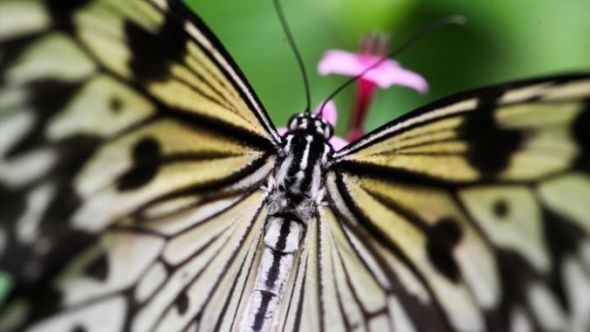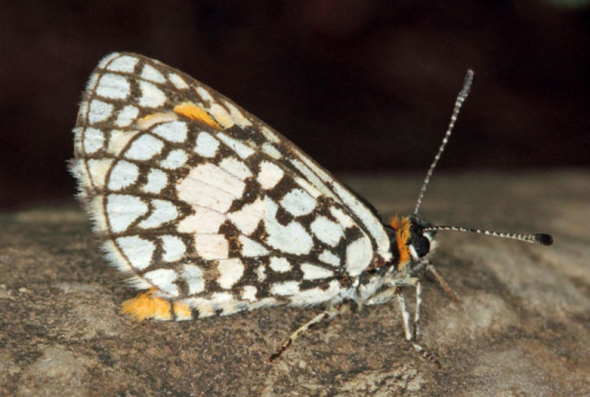Endangered Species Monday: Alaena margaritacea
Endangered Species Monday: Alaena margaritacea
This Mondays (ESP) Endangered Species Watch Post we take a brief glance at South Africa’s most endangered species of butterfly. Generically identified as Alaena margaritacea the species was primarily located by Dr Harry Eltringham FRS (18 May 1873, South Shields - 26 November 1941, from Stroud) whom was an English histologist and entomologist who specialized in Lepidoptera. (Image: unknown photographer)
Dr Eltringham had been awarded a Master of Science (Cantab and Oxon) and a Doctor of Science (Oxon). He worked at the Hope Department of Entomology. He wrote Histological and Illustrative Methods for Entomologists OCLC 03655743, The Senses of Insects, London, Methuen (1933) and on Lepidoptera Nymphalidae: Subfamily Acraeinae. Lepidopterorum Catalogus 11:1-65 with Karl Jordan (1913) and On specific and mimetic relationships in the genus Heliconius.
Commonly known as the Wolkberg Zulu butterfly and identified back in 1929 the species stands within ‘threatened’ status of which has qualified for vulnerable listing. Endemic to a wee small town of South Africa the butterfly is from the family Lycaenidae which is the (second largest family of butterflies on the planet), hosting some 5,000 species and, constitutes 30% of the butterfly species on Planet Earth.
A. margaritacea is known to inhabit grassy slopes adjoining afromontane forest in the Haenertsburg area of the Limpopo Province near the Wolkberg. Populations trends are currently not known however we do know that flora alien (non-native botanical specimens) are placing the only two known colonies of Wolkberg Zulu butterflies within that area in [extreme danger], back in 2013-2014 a second colony was located to the joy of many.
To give you a clearer image of just how threatened the species is (any such habitat disturbance within their known range could see extinction occur within days rather than months or years).
However its not all doom and gloom yet. There is hope, even within a country that’s habitat is slowly being destroyed by agriculture, aquaculture and urbanization. Three years ago the species was believed to have gone extinct. However an intensive search was mounted by members of the Lepidopterists’ Society of Africa.
Despite being identified back in 1929 the species has only ever been known to occur in one single location: a small town in northern South Africa in Polokwane within the town of Haenertsberg. The wingspan is 24–27 mm for males and 28–30 mm for females. Adults are on wing from late December to early January. There is one generation per year. Lepidopterists’ Society of Africa spokesperson Naturalist Andre Coetzer stated that as yet none has been able to locate a third colony (2014).
The species has a habit of settling very frequently and for very long periods … which makes searching for the butterfly a tedious, challenging task involving long treks over rocky terrain while combing and scrutinizing the grass and undergrowth. And there’s another problem: the Wolkberg Zulu has an extremely short flight period (the ‘winged’ adult part of its life cycle) – just three weeks in December and early January that also happens to fall right in the middle of the rainy season. All of this easily explains why no one has found another colony of this elusive and endangered butterfly in the last 80 years. Until now… Please read more here to learn more on the butterfly. For fuether information please contact the organisation directly - click here
A typical liquid diet consists of nectar from flowers but also eat tree sap, dung, pollen, or rotting fruit. They are attracted to sodium found in salt and sweat too.
The word Lepidoptera is derived from the Latin words “lepido” meaning scale, and “ptera” meaning wings. Lepidoptera literally means scale wings, referring to the minute scale-like structures on the wings of both butterflies and moths. We are unsure as to how many Wolkberg Zulu Butterflies actually live within the two colonies, there could be anything from 100-200 (random guess). Which is why we please ask all our readers to make a donation to the Lepidopterists Society of Africa to secure more projects.
Image: Wolkberg Zulu butterfly
For now we remain skeptical and whether there will be more colonies located. We are praying for more colonies to be located. The Department of Environmental Affairs must do more to protect their lands from invasive botanical species to ensure future survival of all flora and fauna. Not forgetting establishing a funding program, protected and manned area to secure their South Africa’s critically endangered butterfly. Failing this we’ll lose South Africa’s most rarest butterfly known to humankind.
Threats
The only known threat to be placing the species in direct danger are that of alien botanical species. Habitat destruction is not known to be problematic within the region although agriculture and human disturbance could very well become a problem. For more information on alien invasive species please see click here for further information.
Unfortunately folks we do not have a video to show of this amazing video but hope one is made available soon. Video footage of this amazing yet so very rare butterfly would be wonderful to view. Please don’t forget to check out the links above and, donate if you can to the group Lepidopterists’ Society of Africa.
Thank you for reading.
Dr Jose C. Depre.
Chief Environmental and Botanical Scientist.





